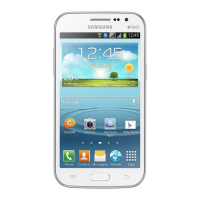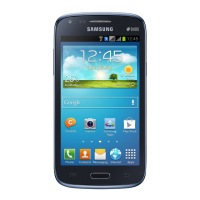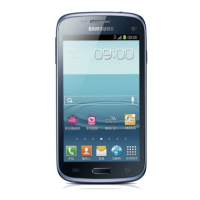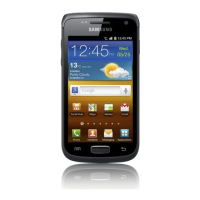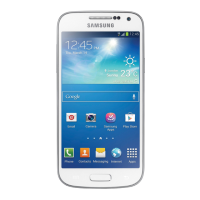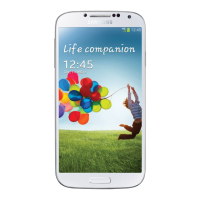Do you have a question about the Samsung GT-I8910 and is the answer not in the manual?
Provides essential guidance on how to effectively use this user manual and its features.
Explains the meaning and usage of various icons presented throughout the manual.
Details the copyrights and trademarks associated with the device and its software.
Instructions for checking product box contents and understanding the device's physical layout.
Guides through SIM/battery installation, charging, and memory card insertion.
Covers turning the device on/off, screen locking, touch screen usage, and accessing help.
Learn basic call functions, sending messages, entering text, and managing contacts.
Basic camera functions, options, media playback (music), and device customization.
Learn to use messaging, including text, multimedia, and email functions.
Manage email, voice mail, and view communication logs.
Explains icons in the inbox and outbox status for messages.
Manage and view your media files like photos and videos.
Listen to FM radio and play media files or stream content.
Play videos, record audio, and connect to a PC for file management.
Manage contact cards, groups, speed dial, and assign ringtones.
Keep track of events, create notes, and synchronize them with other devices.
Work with Quickoffice documents and view Adobe PDF files.
Essential requirements for connecting to the wireless web and navigating pages.
Customize browser settings, page preferences, privacy, and add bookmarks.
Get news and information by creating, updating, and reading RSS feeds.
Create and manage access points for data connections and connect to WLAN networks.
Connect to Bluetooth devices and PCs via USB for data transfer and management.
Synchronize data with Windows Media Player and share media.
Use built-in utilities for calculations, timekeeping, and unit conversions.
Utilize GPS data for navigation, monitor trip details, and manage landmarks.
Capture information, look up words, and print items.
Listen to podcasts and use location services for social networking.
Search, organize, back up, restore, format, and protect files and folders.
Install, manage, and remove applications on your device.
Create/manage zip archives and view/close data connections.
Customize display themes, home screen, date, time, language, and accessories.
Configure application installation, call handling, and network connectivity.
Configure packet data, presence, SIP, XDM profile, and APN control settings.
Resolving issues with password/PIN prompts, forgotten codes, and no network signal.
Troubleshooting calls not dialling, poor sound, or battery charging issues.
Resolving frozen applications, device heating, and Bluetooth connection problems.
Provides essential guidance on how to effectively use this user manual and its features.
Explains the meaning and usage of various icons presented throughout the manual.
Details the copyrights and trademarks associated with the device and its software.
Instructions for checking product box contents and understanding the device's physical layout.
Guides through SIM/battery installation, charging, and memory card insertion.
Covers turning the device on/off, screen locking, touch screen usage, and accessing help.
Learn basic call functions, sending messages, entering text, and managing contacts.
Basic camera functions, options, media playback (music), and device customization.
Learn to use messaging, including text, multimedia, and email functions.
Manage email, voice mail, and view communication logs.
Explains icons in the inbox and outbox status for messages.
Manage and view your media files like photos and videos.
Listen to FM radio and play media files or stream content.
Play videos, record audio, and connect to a PC for file management.
Manage contact cards, groups, speed dial, and assign ringtones.
Keep track of events, create notes, and synchronize them with other devices.
Work with Quickoffice documents and view Adobe PDF files.
Essential requirements for connecting to the wireless web and navigating pages.
Customize browser settings, page preferences, privacy, and add bookmarks.
Get news and information by creating, updating, and reading RSS feeds.
Create and manage access points for data connections and connect to WLAN networks.
Connect to Bluetooth devices and PCs via USB for data transfer and management.
Synchronize data with Windows Media Player and share media.
Use built-in utilities for calculations, timekeeping, and unit conversions.
Utilize GPS data for navigation, monitor trip details, and manage landmarks.
Capture information, look up words, and print items.
Listen to podcasts and use location services for social networking.
Search, organize, back up, restore, format, and protect files and folders.
Install, manage, and remove applications on your device.
Create/manage zip archives and view/close data connections.
Customize display themes, home screen, date, time, language, and accessories.
Configure application installation, call handling, and network connectivity.
Configure packet data, presence, SIP, XDM profile, and APN control settings.
Resolving issues with password/PIN prompts, forgotten codes, and no network signal.
Troubleshooting calls not dialling, poor sound, or battery charging issues.
Resolving frozen applications, device heating, and Bluetooth connection problems.
| Model | GT-I8910 |
|---|---|
| Announced | 2009, February |
| Released | 2009, June |
| Technology | GSM / HSPA |
| 2G bands | GSM 850 / 900 / 1800 / 1900 |
| GPRS | Class 12 |
| EDGE | Class 12 |
| Dimensions | 123 x 58 x 12.9 mm (4.84 x 2.28 x 0.51 in) |
| SIM | Mini-SIM |
| Protection | Corning Gorilla Glass |
| Chipset | TI OMAP 3430 |
| CPU | 600 MHz ARM Cortex-A8 |
| GPU | PowerVR SGX530 |
| Main Camera | 8 MP, AF |
| Video | 720p@24fps |
| Front Camera | No |
| Loudspeaker | Yes, with stereo speakers |
| 3.5mm jack | Yes |
| WLAN | Wi-Fi 802.11 b/g, DLNA |
| Bluetooth | 2.0, A2DP |
| GPS | Yes, with A-GPS |
| Radio | Stereo FM radio, RDS |
| USB | microUSB 2.0 |
| Sensors | Accelerometer, proximity, compass |
| Java | Yes, MIDP 2.0 |
| Battery | Removable Li-Ion 1500 mAh battery |
| Colors | Black |
| RAM | 256 MB |
| Network | GSM / HSPA |
| 3G bands | HSDPA 900 / 2100 |
| Display Type | AMOLED |
| Display Size | 3.7 inches |
| Resolution | 360 x 640 pixels |
| Operating System | Symbian OS v9.4 |
| Card slot | microSD, up to 32 GB |
| Internal Storage | 8/16 GB |
| Camera Features | LED flash, geo-tagging, face detection |
| Browser | HTML |
| Stand-by | Up to 600 h |
| Connectivity | Wi-Fi, Bluetooth, USB |


